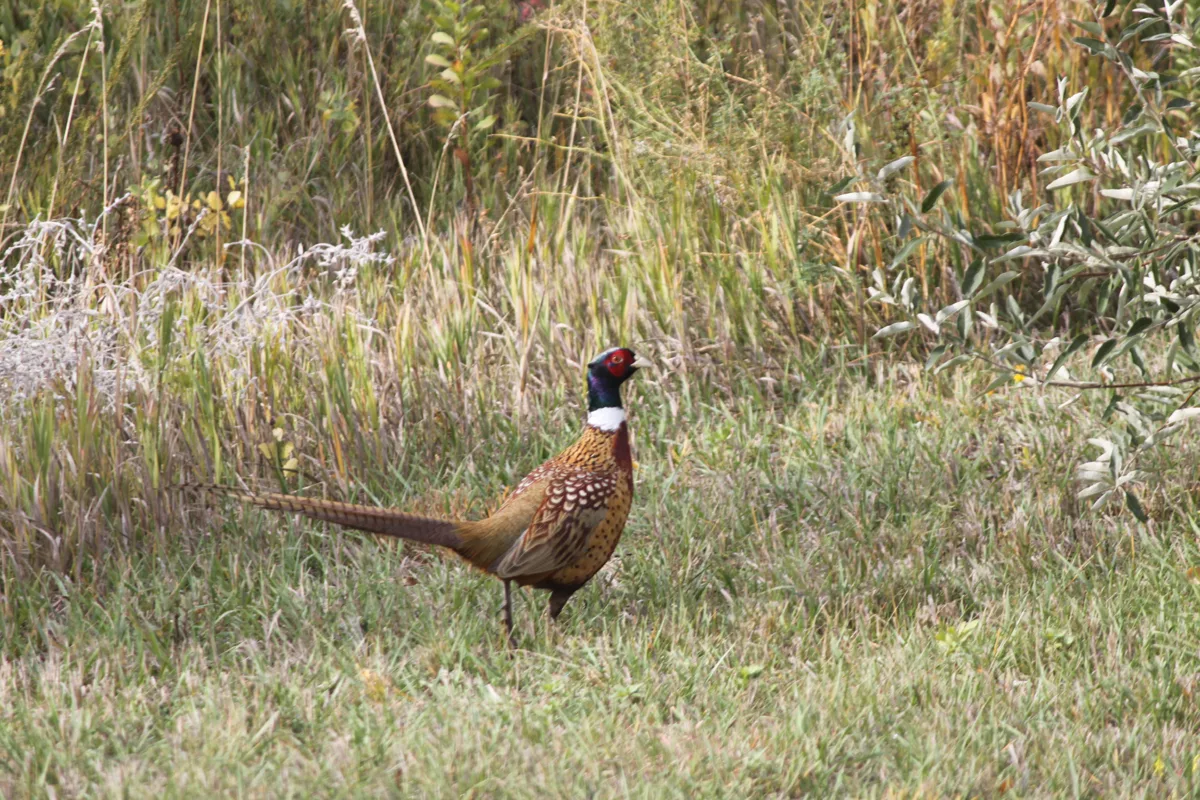
On the Lookout. Pheasants are cagey birds, but they have their trends and tactics for escape. Know what to expect from them (most of the time) and you’ll find better success in the field. Simonson Photo.
By Nick Simonson
As I climbed the asphalt grade from the river bottom on the back part of my weekend long run (and lamented the final two miles of windedness that were to come after it) I caught the cackle of an early morning rooster in the valley below and thought of where I’d be in seven days with the coming ND pheasant opener. Likely, I’d be doing the same thing, scaling a grade in hot pursuit of my lab, led by some unseen scent trail in the grassy cover which would be a welcome substitute for the pavement under my bright green running shoes. They would also be replaced by the worn brown leather of my favorite hunting boots. Thankfully too, I remembered one of my never-fail, always guaranteed, (read: not a guarantee) field sayings: “roosters never run uphill” and laughed remembering a couple times they did.
Most of the time however, when pushed to the steepest part of a rise or challenged with the gnashing teeth or stutter step of my dog, roosters were quick to abandon their legs and take to the skies anytime the incline worsened. Utilizing those first few powerful wingbeats to get aloft and send the surge of adrenaline through my body (a sensation the four-tenths of a mile climb could have benefitted from) ahead of the shot, more often than not those wily favorites of the uplands held true to the adage. But it’s tough to pigeon-hole a pheasant, namely because they’re bigger, wilier and have to avoid sneakier predators than their underpass-dwelling avian cousins. However, there are a few other field sayings to consider as the season’s start approaches and your strategy sets up.
Pause at the Edge
On any good piece of habitat, working it right up to the very edge often provides an amazing conclusion to some challenging field exercise. Whether that’s a finger of a cattail slough jutting out into a just-harvested field, the terminus of a shelterbelt with some nice brush and low grasses around the base of the trees, or simply the end of a stretch of CRP against a gravel road, birds often wait at the very end. Before closing it out, pause about 20 yards before the end of the cover and count to 20 before finishing it out. Oftentimes that moment will trigger some great flushes, makeable shots and good opportunities to bag a bird.
The Big Four
In those places where gravel, cover, ag and water meet or are all contained within the same walk, you’re likely to find pheasants. This brings together the four things that birds need to survive, and gives them little reason to leave, or travel very far in their daily movements. Thus, they can likely be found where gravel roads hem in a small slough with adjacent grass and a nearby field. The element of water can be a bit trickier, but any source will help, including stock ponds, creeks, even a lake edge with a nice cattail buffer. Before setting out, glass an area about to be walked and add these elements up; if all four are there in close proximity, you’re likely in for a good walk.
In a Pinch
Those same creeks mentioned above also provide great chances to hem pheasants in and force them to flush. The winding of a small waterway creates larger chunks of riparian grass that eventually taper off into small points. It’s in those areas that roosters quickly realize they are about to lose real estate to run on and take to the skies. Work the wide areas slowly and methodically to cover the area well and push birds up into the thinner spots where they’re likely to fly. It doesn’t have to be a creek that creates a pinch point either, natural rises in the land can do it along with field edges and other man-made features as well. Any place cover goes from wide to skinny is worth a look.
Fully Loaded
It may be tempting at the end of a long walk to unload your gun before you’ve finished out to get ready for the next trip to an adjacent parcel or another hunting spot down the road. However, more than my fair share of roosters have come within 50 yards of the pickup truck as a hunt was winding down. Don’t be surprised if a running rooster has snuck his way close to your vehicle after being bumped around as you explored most of an area with your dog. Instead of telling the tale of the rooster that flushed at your bumper and got away due to an early unload, be ready for anything until the last step and then empty out when you’re about to open the tailgate to get Rover his water dish. Just make sure the shot is a safe one.
As referenced above, not all of these are guarantees in the field. Pheasants are smart, evasive and fast. They’ll utilize the path of least resistance and know of at least a couple more beyond what you can obviously see on the landscape. Give them credit where credit is due, but also know those places and the strategies that produce more often than not. Keeping these things in mind and other situational specifics you’ve experienced in pursuit of roosters will make for a more successful opener and a great upland season…in our outdoors.
